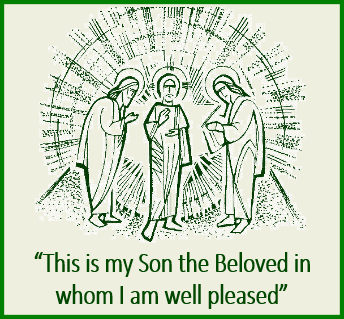Homily for the Feast of the Transfiguration (6th August 2023)
Readings: Daniel 7:9-10; Peter 1:16-19; Matthew 17:1-9
Theme: ‘I looked at Christ transfigured without fear’ (Patrick Kavanagh)
The Transfiguration of Jesus, portrayed in today’s gospel, has captured the imagination of artists down through the ages. Among the many paintings, icons and mosaics depicting this extraordinary event, the sixth century mosaic in the monastery of St Catherine in Sinai, the world’s oldest inhabited Christian monastery, is my favourite. I was blessed to have had the opportunity to see it during a pilgrimage to the Holy Land in the Spring of 2008. When I entered the basilica of the monastery, I was immediately struck by the beauty of this awesome mosaic, situated in the apse above the high altar. At its centre is the figure of Jesus transfigured. His right hand is raised in blessing and his eyes directed towards us. His clothes are shining white with gold edging. From his body, rays of light emanate towards each of the five figures present: to his right, the prophet Elijah; to his left, Moses; around his feet, the Apostles John, Peter, and James. This marvellous mosaic captures the drama of this unique event: the three Apostles in a state of shock and bewilderment, while Jesus stands serenely above them, flanked by Moses and Elijah, who appear to be blessing him.
The Transfiguration took place at a critical moment in the life and ministry of Jesus. He had left behind the green valleys and gentle hills of Galilee and taken the road to Jerusalem where violent death awaited him. He realised that, in Jerusalem, he would meet the same fate as the prophets before him. He had already warned his disciples ‘that he was destined to go to Jerusalem and suffer grievously at the hands of the elders and chief priests and scribes, to be put to death and to be raised up on the third day’ (Mt 16: 21). When Peter began to remonstrate with him, refusing to accept his prophetic words, he rebuked him in unusually harsh terms: ‘Get behind me, Satan! You are an obstacle in my path, because the way you think is not God’s way but man’s’ (Mt 16:23). Suffering and death were integral to his salvific mission.
As was the custom of Jesus when facing into danger, he withdrew to a quiet place (a mountain) to pray and reflect, taking with him three of his companions, Peter, James and John. In their presence he is transfigured – ‘his face shone like the sun and his face became as white as the light’ (Mt17: 2). And he appears in conversation with Moses and Elijah. Then, as on the occasion of his baptism, a voice from ‘a bright cloud’, the voice of his Father, affirms his divine identity and messianic vocation: ‘This is my Son, the Beloved; he enjoys my favour. Listen to him’ (Mt 17:7). This affirmation and confirmation of the Father’s love must surely have strengthened him in the face of the dark and threatening future that lay ahead.
The transfiguration experience was important not just for Jesus but also for his beloved disciples. Their eyes were opened to catch a glimpse of Jesus in his glory and their ears were opened to hear the divine confirmation of Jesus’ identity as ‘beloved Son’, to whom they were commanded to listen. Captivated by the experience, Peter wishes to remain on the mountain in the exalted company of Elijah, Moses and Jesus. However, this was not to be. This glorious moment passes, and the three disciples find themselves alone with Jesus who warns them not to tell anyone about what they had seen ‘until the Son of Man has risen from the dead’ (Mt 17:9). The fact that the story of the transfiguration of Jesus is narrated in all three synoptic gospels – Matthew, Mark and Luke – indicates its significance for the early Christian community. In the words of the popular New Testament scholar, NT Wright: ‘It demonstrates, for those with eyes to see, and ears to hear, that Jesus is the place where God’s world and ours meet…. It forms part of a new set of signposts, Jesus-shaped signposts, indicating what is to come: a whole new creation, starting with Jesus himself as the seed that is sown in the earth and then rises to become the beginning of that new world.’
Today’s gospel may prompt us to recall transfiguration moments in our own lives – moments of light, joy and peace; moments when we caught a glimpse of a transcendent beauty beyond the horizon of the habitual; moments that, in the striking words of the poet, Seamus Heaney, ‘catch the heart off guard and blow it open’. While such moments may not transform us, for they are always fleeting, they surely heighten our awareness of a sustaining presence that helps us cope with times of fear and uncertainty. They carry us forward in hope of ‘a new world in the morning’, to borrow the title of a song by Roger Whittaker. But, as Jesus reminded Peter, we cannot remain on the mountain and bask in warmth of such consoling experiences. We must return to the humdrum of daily living among our brothers and sisters. In the words of Pope Francis, ‘Our Christian faith is not meant just to give us beautiful spiritual feelings. That is not the message of Jesus. We are called to experience the encounter with Christ so that, enlightened by his light, we might take it and make it shine everywhere’. May our celebration of the Eucharist on this great feast help us to do just that!
Michael McCabe SMA
To listen to an alternative Homily for this Sunday, from Fr Tom Casey of the SMA Media Centre, Ndola, Zambia please click on the play button below.
|
|

